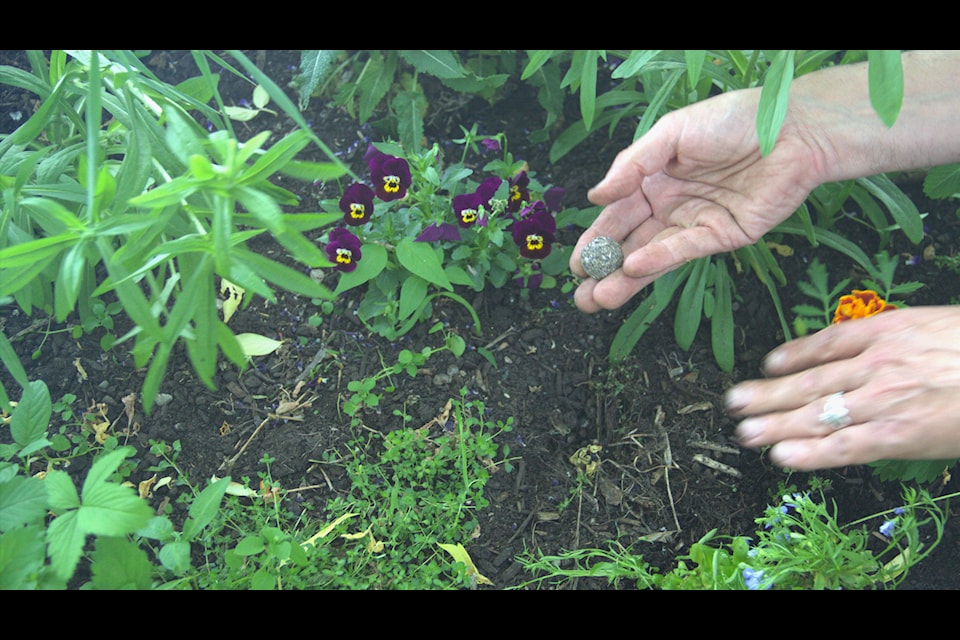Artist Martin Reis' Ring Post Garden Project beautifies spaces by planting flower seedlings in bike posts.
Artist Martin Reis is on a botanically-inspired quest to turn Toronto’s streets into miniature gardens.
With The Ring Post Garden Project, he is planting flowers in bike ring posts whose tops are missing.
“I was walking down the street and I noticed that a lot of the bike ring posts had lost their caps. And I thought, 'Hey, this is an opportunity to do something positive,'” Reis said.
He arms himself with a sling bag, a water bottle and a bag that safely keeps the flowers.
In this bucolic blend, Reis also carries a pair of chopsticks and a small garbage bag as these empty posts are often filled with garbage.
Reis picks out cigarette stubs, chewing gum and Styrofoam cups and cleans the post before layering it with round cardboard cut-outs.
He puts potting soil on the cardboard and then adds the flower seedling. He says he learned this technique of lasagna gardening from his friend, Lisa Savard-Quong.
Thanks to Reis’ efforts that began at the beginning of May, the streets of Bloor, Christie, Harbord and Spadina are now blooming with more than 30 flower seedlings in varieties of marigolds, blue wonder and baby blue eyes.
He plants up to 10 flower seedlings a day and aims to fulfil a target of 60 flowers.
“That will be enough for me to handle for one person,” he said.
The activity doesn’t come without its challenges. The tender buds are vulnerable to environmental damage as well as people.
“I go back every second or third day and make sure there’s enough water,” Reis said. “I noticed that one of the plants on Christie Street that I just put in, which was a really nice marigold, had actually gotten taken out really fast.”
But Reis says he takes it on the chin.
“I figured there [are] so many students and maybe young couples around there. Somebody was trying to impress his girlfriend or boyfriend,” he said.
When this happens, Reis plants seed bombs that he makes himself using 50 per cent cat litter, 50 per cent compost and native plant seeds.
“They provide a clandestine way of growing something without anybody really noticing and bothering it. People leave them alone,” Reis said. “Those are usually resilient, like old wildflowers, which are used to being outside all the time. [They are] non-destructive and also good for pollinating.”
However, what worries Reis is that people might mistake him for a bicycle thief. It’s almost comical when he raises his hands in surrender and says that he waits until people leave with their bikes before he begins gardening.
“I try to be careful with that. I usually wait until they leave. I'm not a bicycle thief. I'm a guerrilla gardener,” he said.
The history of guerilla gardening in Canada dates back two centuries. A McGill University paper titled “A Social History of Urban Agriculture in Montreal” traces the Railway Gardens to 1890. It notes that the two world wars gave rise to vacant lot gardens.
“There is a subculture in Toronto that already exists of guerrilla gardening," Reis said. "If you go along rail paths, people have planted gardens along railroad tracks. There’s a long tradition of taking land and reusing it.
"And generally, guerrilla gardening is either for beautifying spaces or using it for crops,” he said.
Reis, who works with the music ensemble Tafelmusik, says this is an exercise in meditation for him.
“It's very meditative for me, especially when you're working with the earth. It provides a lot of balance for me,” he said.
This idea, like with his past public art projects like the Tour de Lego or The Trees Have Spoken, aims to plant a larger, inclusive idea in the community.
“I'm more interested in planting ideas in people’s eyes and heads and beautifying things for the moment,” Reis said.
In the few weeks since he undertook the project, Reis has noticed that even if the flowers are taken out of the bike ring posts, people have stopped using them as garbage bins.
“Nobody’s putting in any debris or trash back in after the soil has been disturbed or when the seedling gets taken out. It’s a good way of cleaning up the space and permanently changing it for something that’s more natural,” he said.



